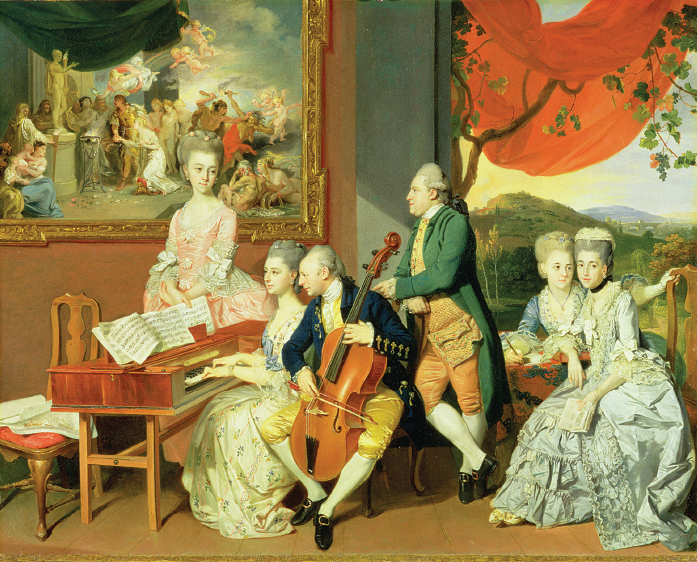Tone Color: The Classical Orchestra
Classical composers also devoted increasing attention to tone color. The clearest sign of this was the emergence of the Classical orchestra. The orchestra standardized in this period formed the basis of the symphony orchestra of later times.
The heart of the Classical orchestra was still (as in the Baroque orchestra) a group of stringed instruments: violins, divided into two groups, first violins and second violins; violas; and cellos, with a few basses playing the same music as the cellos an octave lower. As we saw on pages 108–09, there was a basic Baroque orchestra consisting of just these instruments plus the continuo, and various other possibilities, including the festive Baroque orchestra:
| THE BAROQUE ORCHESTRA | |
| STRINGS | KEYBOARD |
| Violins (divided into two groups, called violins 1 and violins 2) | Harpsichord or organ |
| Violas | |
| Cellos | |
| Bass (playing the same music as the cellos an octave lower) | |
| THE FESTIVE BAROQUE ORCHESTRA | ||||
| STRINGS | WOODWINDS | BRASS | PERCUSSION | KEYBOARD |
| Violins 1 | 2 Oboes | 3 Trumpets | 2 Timpani (kettledrums) | Harpsichord or organ |
| Violins 2 | 1 Bassoon | |||
| Violas | ||||
| Cellos | ||||
| Bass | ||||
In the Classical orchestra, however, the woodwind and brass instruments were given clearly defined, regular roles. With the strings as a framework, woodwind instruments were added: in the high range, pairs of flutes, oboes, and (a bit later) clarinets; in the low, bassoons. These instruments provided “pleasing variety” by playing certain melodies and other passages; each of the woodwinds contributed its own intriguing tone color or timbre. They also strengthened the strings in loud sections.
| THE CLASSICAL ORCHESTRA | |||
| STRINGS | WOODWINDS | BRASS | PERCUSSION |
| Violins 1 | 2 Flutes | 2 French horns | 2 Timpani (kettledrums) |
| Violins 2 | 2 Oboes | 2 Trumpets* | |
| Violas | 2 Clarinets* | ||
| Cellos | 2 Bassoons | ||
| Basses | *Optional | *Optional | |
Brass instruments were added in the middle range. The function of French horns and trumpets was mainly to provide solid support for the main harmonies, especially at points such as cadences, when the harmonies needed to be made particularly clear. But sometimes they played lively (short) solos. The only regular percussion instruments used were two timpani, which generally played along with the brass.
The great advance in the orchestra from the Baroque to the Classical era was in flexibility — flexibility in tone color and also in rhythm and dynamics. The orchestra now became the most varied and versatile musical resource that composers could employ, as well as the grandest.
